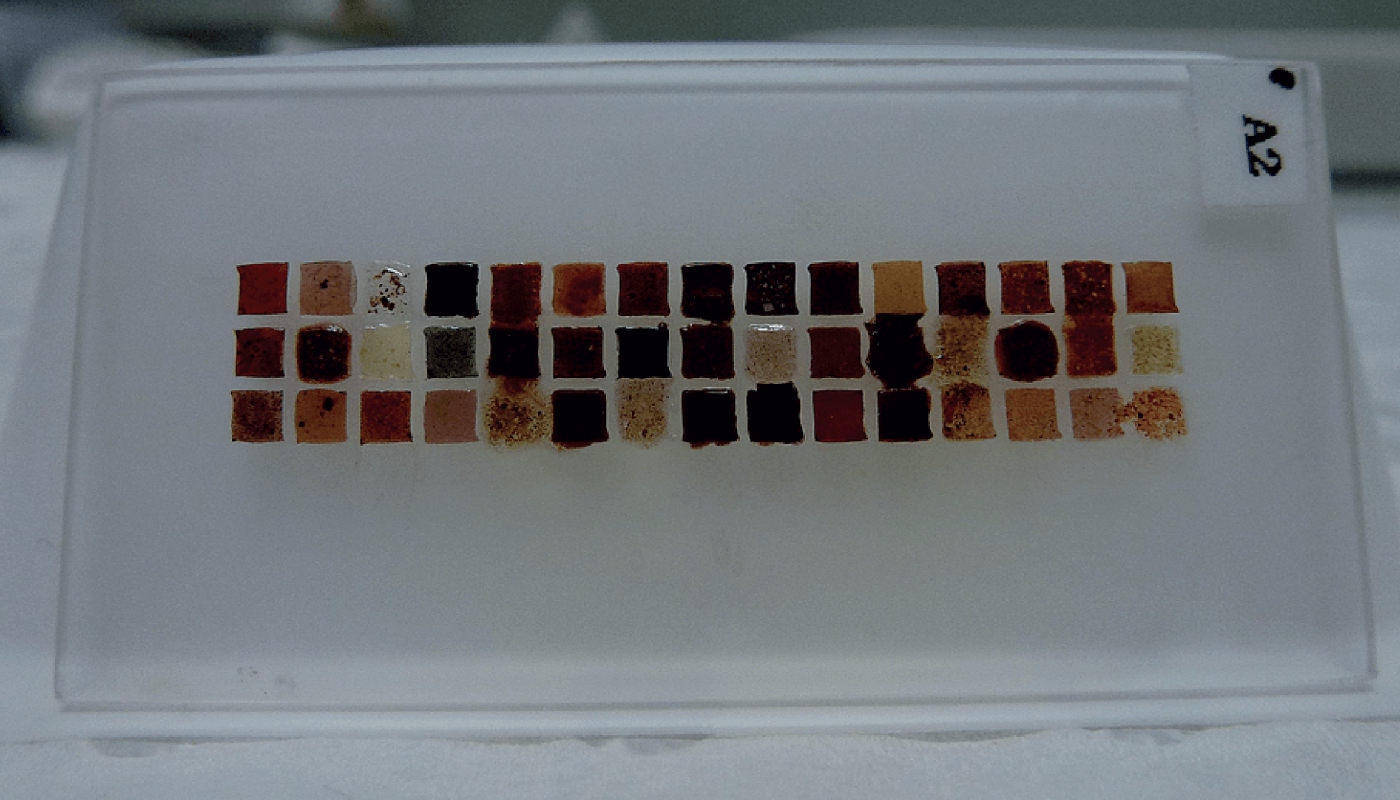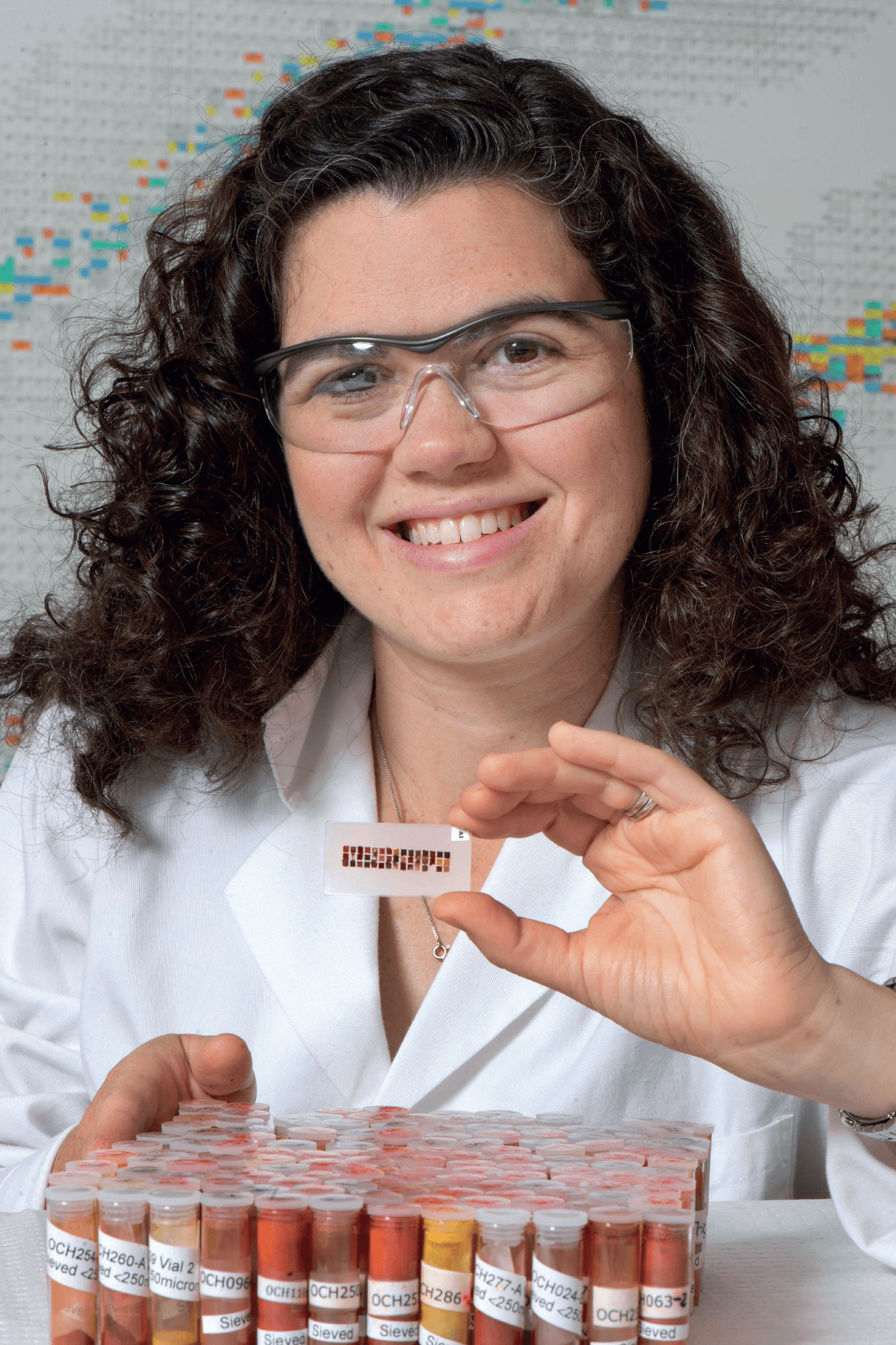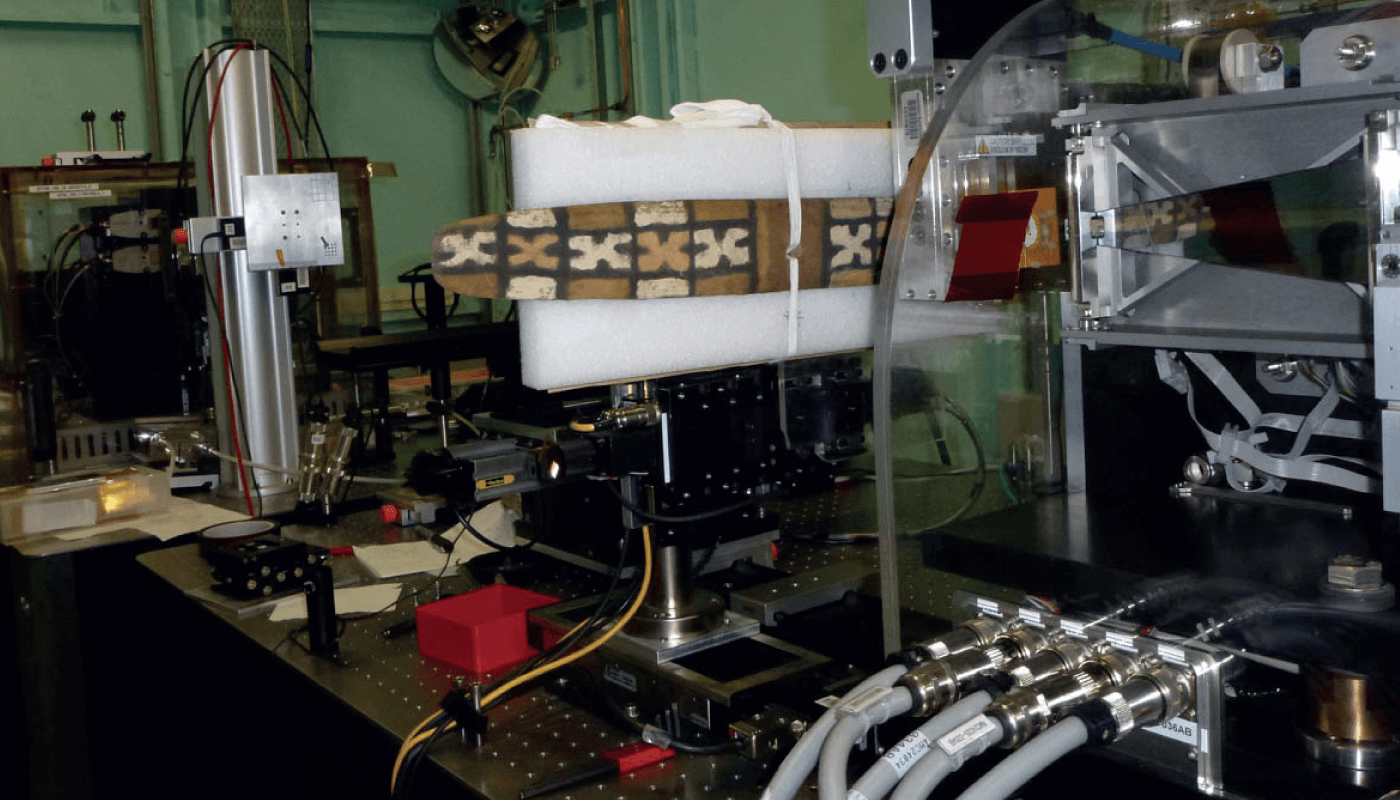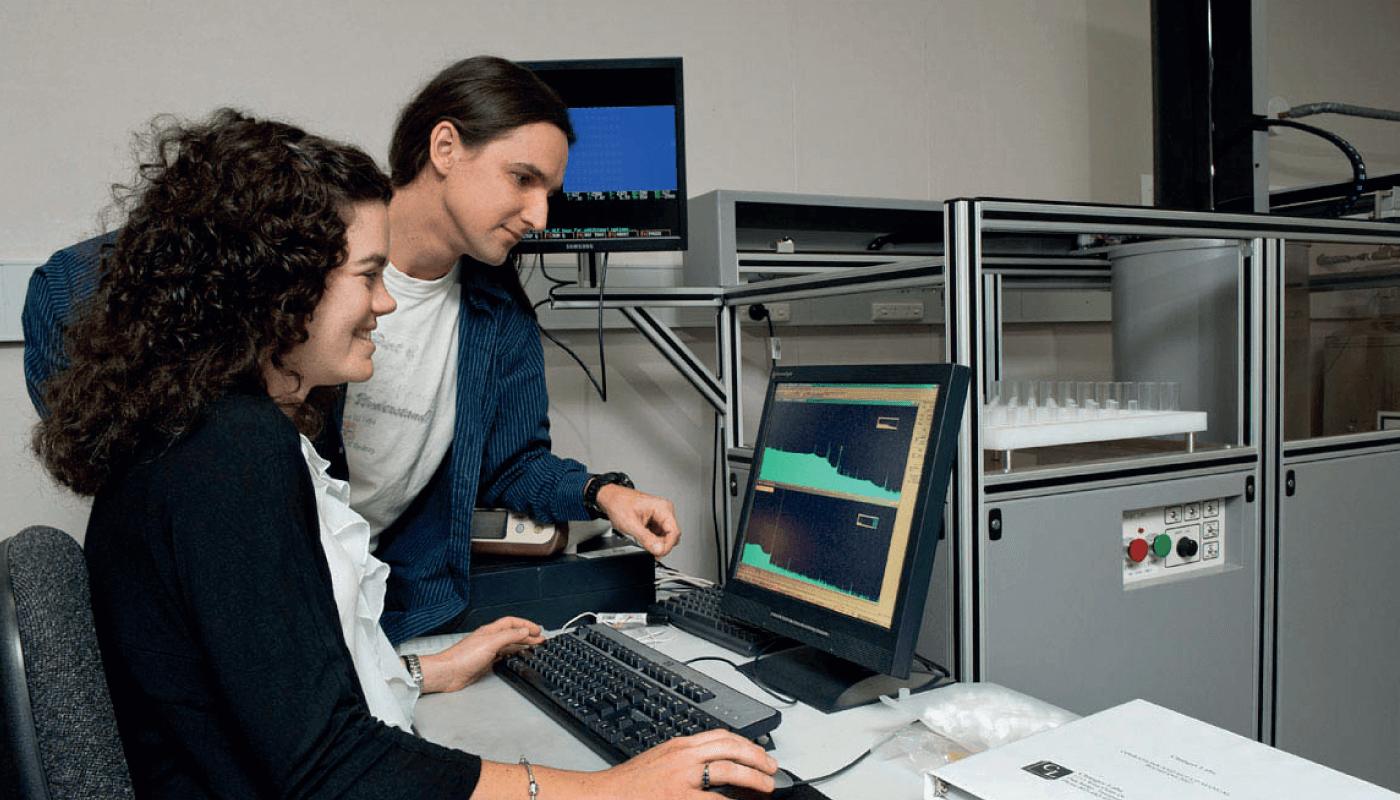
Take a moment to reflect on the objects that are in your immediate vicinity. Depending on their composition, some of these objects may communicate cultural information that transcends generations. Those objects that are fundamental to our cultural expression often also reflect traditions that go back decades, if not centuries. Some of these may end up in museums - others may remain treasured family heirlooms.
Unfortunately, history often displaces communities or disconnects them from these culturally significant objects, meaning our own connection to the past is lost for generations as well. But chemical characterization offers an insight into these lost connections and our collective humanity. Despite differing environments and contexts, communities around the world often use the same materials for the same purposes – for example, the natural mineral earth pigments used in rock art. Modern analytical approaches – combined with fundamental questions about the exchange of materials, movement of populations, and uses of materials – help us to not only understand our past, but to inform our use of these same materials in today’s society.
Though the context (such as archeological stratigraphy) or documentation (such as historical writings) on an object are useful in providing framework, they are often not available. Often, the only way to reconstruct cultural interactions lost to time is through analytical chemistry. Chemical analyses help us answer questions regarding the materials used to make objects, the use of the object itself, and whether it was made locally or exchanged from a distance.
Cultural heritage objects are a complex mix of materials and technologies. And, unlike materials produced in the lab, unique considerations must be taken into account when analyzing them. Though some of the analyses are based on established methods, the process is not as straightforward as an industrial or routine analysis. For example, mineral pigments mixed in with plant-based binders are mixtures of inorganic and organic components. For these multimedia samples, a single analytical approach may not be optimized or sufficient to fully understand the composition of both materials – or the interactions between the two. Therefore, it is imperative to build a fundamental understanding of the materials alongside any analytical approaches employed.
An additional layer of complexity also surrounds the approach to analysis. Unlike lab-synthesized samples, cultural heritage materials are often limited by access and permissions. On top of this, materials may have continuing cultural significance to communities today, or be in very limited supply. This means additional considerations must be taken to ensure analysis is non-destructive. Alternatively, where possible, micro-sampling is the way to go.
I have studied several different categories of cultural materials across my career, including pigments, ceramics, metals, glass and stone tools. In my recent appointment as the Kimberley Foundation Minderoo Chair in Archeological Science at the University of Melbourne, I am establishing a new teaching program and laboratory, as well as leading new initiatives in archeological science focused on geologically based materials. This program builds on the strengths of the existing collaborations with Rock Art Australia and other partners towards developing novel methods of analysis and dating of rock art. For the past 20 years, my work alongside colleagues in both the natural and social sciences at universities and museums has focused on natural mineral pigments – specifically, examining Indigenous materials in North and South America, as well as Australia. However, the use of these pigments is universal across cultures and communities the world over, and these traditions have continued today through both cultural uses and modern engineering applications.
I have been investigating the provenance and composition of ochre-based pigments. These pigments are common worldwide but are of significant importance in Aboriginal Australian cultural tradition – in the past and through to the present day. The pigments applied to objects or rock art reflect the natural variation of the original source in terms of mineral and elemental distribution of particle shapes and sizes. Our group and collaborators have demonstrated that elemental and genomic analysis of ochre pigments can be used to uncover the provenance of a material right back to its geological source – as well as understand its cultural technology. And that means chemical analysis can enable researchers to reconstruct ancient exchange routes, and even offer useful information for future conservation studies.

Ochre is a collective term for iron-based oxide pigments, primarily iron oxides (hematite and red pigments) and iron hydroxides (goethite and yellow pigments), but ochre materials ultimately cover a spectrum of mineral composition mixtures and colors. Rather than focusing on the mineralogical composition, we decided to focus on the characterization of the “elemental fingerprint” of Australian ochre to allow us to differentiate between sources. We started by using k0-neutron activation analysis (k0-NAA) – at the OPAL nuclear research reactor of the Australian Nuclear Science and Technology Organisation (ANSTO) – to study ochre samples from several sites around South Australia to characterize the elemental profile (1, 2).

NAA is a useful technique as it requires 50 milligram amounts of sample for each bulk analysis. Yet, it still provides excellent precision and accuracy on different elements from percent down to the ppb level simultaneously. NAA has lower detection limits and higher precision than techniques like X-ray fluorescence spectroscopy (XRF) because NAA utilizes fundamental nuclear processes. Therefore, results are therefore less affected by matrix interferences – often a limiting factor for XRF.
Thus, we were able to precisely and accurately quantify the bulk elemental concentrations of both the major and trace components of rare earth elements, transition elements and major composition elements in ochre. Using a log ratio method, we corrected for the majority iron concentration and subsequently removed elements that statistically correlated with iron. We then used principal component analysis and canonical discriminant analysis to differentiate ochre from different source locations across large geographic distances within a 90 percent confidence interval. These efforts established an important comparison database for understanding the provenance of ochre pigments without relying solely on contextual cultural information.
A bulk analysis of ochre sources captures the average of any sample, but as this is an inherently complex material of multiple minerals and phases, it does not capture the contributions from individual grains. In addition, higher spatial resolution analysis is required to analyze the fine lines or thin layers of ochre often applied to substrates to create cultural heritage objects like boomerangs and bark paintings. Removing samples of these thin layers is also potentially disfiguring, so a non-destructive technique is required.
We therefore used the XFM beamline at the Australian Synchrotron to analyze both the source ochre and some ochre-treated objects (3, 4). This non-destructive analysis allows high-resolution (10-50 micron spot size) and semiquantitative elemental mapping of the applied mineral pigments. Using GeoPIXE software and modeling, we produced “heat maps” of elemental composition across the painted object based on spectral data. Creating heat maps of three elements in unison allowed us to identify a diversity of particle shapes, sizes and compositions, and identified that samples from the same geological source can still demonstrate variation on the micron scale.

Using these approaches, we visualized the application of pigments, including solid painted areas, fine lines and cross-hatching to an Aboriginal Australian boomerang and bark painting. Not only did we identify the major composition of the ochre pigments, including the differences between red and yellow pigments, but we also identified trace amounts of other elements such as rubidium. Thanks to the resolution of this technique, it was possible to visualize the fibers of the bark substrate beneath the pigment layer, too.
We were also able to model and estimate the thickness of pigments – about 40 microns – and gain a better understanding of the composition of pigments versus their color. Surprisingly, some of the yellow pigments were more iron-heavy than the red pigments. And, in particular areas, we could actually surmise the application order of layered pigments - deciphering the artist’s application process. These elemental results agreed with our previous studies on the mineral composition of various red, yellow, black and white mineral pigments using an instrument adapted from the mining industry (see "From Mining to Mineral Analysis" below for more information).
But that’s not all. With colleagues at Flinders University, we are also expanding the archeological science field further by investigating the role of microbial communities in the provenance of ochre (5,6). This method is established in forensic soil analysis and provides a unique perspective into the provenance of geological materials through a better understanding of their more recent environments, rather than those in the geological past.
To our knowledge, this is the first time DNA profiling has been used to determine the archaeological provenance of geological materials. We have previously demonstrated in a proof-of-concept paper that we can use 16SrRNA along with canonical analysis of principal coordinates to genetically profile ochre sources and distinguish between four ochre sites through their microbe profiles. These large, genetic data networks lend even more power to our investigations.
By adapting a technique used in the mining industry – the HyLogger™ spectrometer – we developed an approach to non-destructively analyze and identify mineral pigments directly on Aboriginal Australian objects, regardless of the substrate or binder. This rapid spectroscopic logging and imaging system enables objects to be viewed in the shortwave-IR (SWIR) and NIR wavelengths – between 400 to 2500nm. As the technique uses two different segments of the electromagnetic spectrum, it allows us to identify other minerals in the pigment that are not visually apparent by color alone. The spot size in this technique is around 0.8 cm2, so does not allow analysis of very fine pigment applications. However, this point-by-point analysis works very well on objects with larger areas of pigment application.

Using this technique, we identified previously unknown minerals in the pigments. The instrument scans at a rate of 1 cm per second, meaning artworks are analyzed within minutes (depending on the size of the object). For each “spectral pixel” analyzed, the instrument provides data on the individual spectrum, color, primary and secondary mineral interpretation, normalized Hull quotient data, and location on the image of the object (in cm). This setup is optimized for a range of minerals that are part of many common earth pigments. In the NIR, minerals containing Fe2+ and Fe3+ can be differentiated by their vibrational properties and the charge transfer between ligands and iron.
In the SWIR, identification of various aluminosilicates and other related minerals are possible. We discovered that the majority of pigments included kaolin, which agrees with cultural information, and that the crystallinity of the kaolin can be determined. However, we also identified gypsum, whewellite and other minerals as pigments or mixtures that had previously not been identified in cultural earth pigments.
Pigments remain a visually captivating medium, and one central to the expression of cultures across the world. In addition to appreciating their appearance, archeological science offers additional layers of interpretation about their technology, composition, and origins. Collaboration with cultural heritage professionals and community partners is essential to understand and design archeological science questions and discuss the use of cultural materials for analysis. Rather than being a potential afterthought on an archeological excavation or museum exhibit, archeological science will become an essential aspect of cultural research.
Through exhibits, programs and media, I hope the general public develops a better understanding of not only the cultural implications of these studies, but also the analytical chemistry methods behind them. No matter where we are in the world, current cultures are interlinked to those of our collective past. The power of analytical science lies in its ability to help us better understand our fundamental, universal connections with each other.

The author acknowledges the diversity of collaborations and publications with researchers at Flinders University, University of Melbourne, ANSTO, Australian Synchrotron, National Virtual Core Library-AuScope, South Australian Museum, Artlab, University of Missouri and Communities, and acknowledges funding from the following: AINSE Research Fellowship, Australian Research Council, University of Melbourne, Rock Art Australia and the Minderoo Foundation.
References
- R Popelka-Filcoff et al., “Evaluation of relative comparator and k0-NAA for characterization of Aboriginal Australian ochre,” Journal of Radioanalytical and Nuclear Chemistry, 291, 19 (2012). DOI: 10.1007/s10967-011-1236-2
- R Popelka-Filcoff et al., “Characterisation of Ochre Sources in South Australia by Neutron Activation Analysis (NAA),”Journal of the Anthropological Society of South Australia, 35, 81 (2012).
- R Popelka-Filcoff et al., “Novel application of X-ray fluorescence microscopy (XFM) for the non-destructive micro-elemental analysis of natural mineral pigments on Aboriginal Australian objects,” Analyst, 141, 3657 (2016). DOI: 10.1039/c5an02065d
- R Popelka-Filcoff et al., “Microelemental characterisation of Aboriginal Australian natural Fe oxide pigments,” Analytical Methods, 7, 7363 (2015). DOI: 10.1039/c5ay01547b
- CE Lenehan et al., “Microbial composition analyses by 16S rRNA sequencing: A proof of concept approach to provenance determination of archaeological ochre,” PLOS ONE, 12, e0185252 (2017). DOI: 10.1371/journal.pone.0185252
- The Conversation, “When bacteria tell a story: tracing Indigenous Australian ochre sources via microbial ‘fingerprinting,’” (2019). Available at: https://bit.ly/34wYCxc
- R Popelka-Filcoff et al., “HyLogger(™) near-infrared spectral analysis: a non-destructive mineral analysis of Aboriginal Australian objects,” Analytical Methods, 6, 1309 (2014). DOI: 10.1039/c3ay41436a




